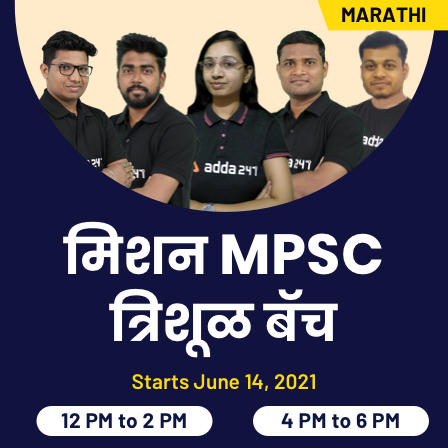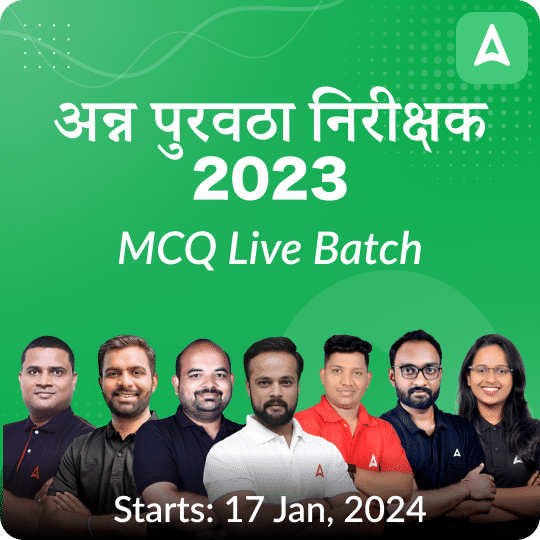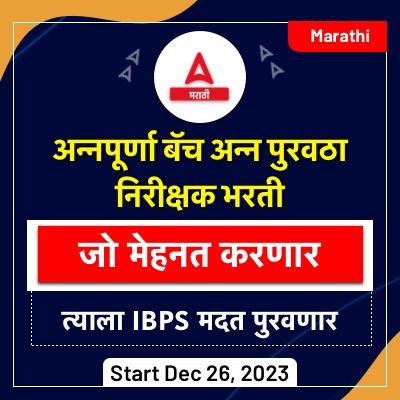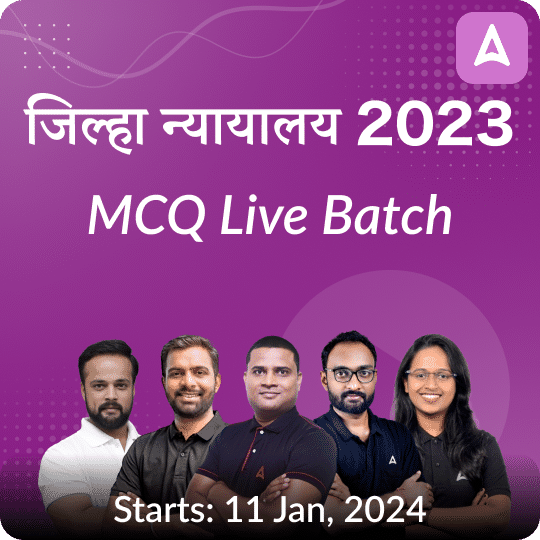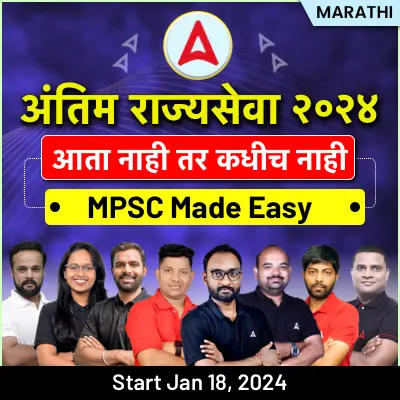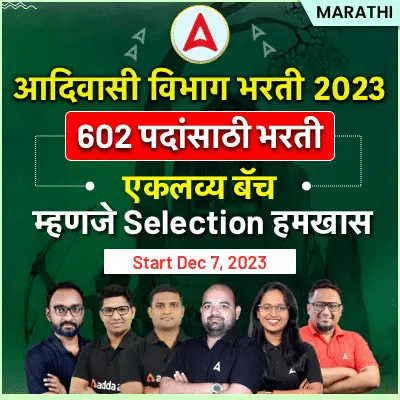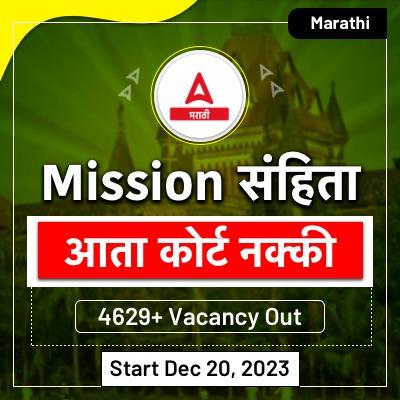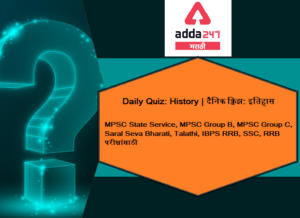
इतिहास दैनिक क्विझ मराठीमध्ये: 3 जून 2021
महाराष्ट्र राज्य लोकसेवा आयोग दरवर्षी वेगवेगळ्या परीक्षे मार्फत हजारो विद्यार्थ्यांची भरती करून घेते MPSC State Service, MPSC Group B, MPSC Group C, Saral Seva Bharati, Talathi, UPSC, SSC, RRB अशा अनेक परीक्षांमार्फत हजारो जागांची भरती दरवर्षी निघते ज्यात लाखो इच्छुक हजार किंवा त्याहूनही कमी जागांसाठी अर्ज करतात. आपण एमपीएससी आणि इतर परीक्षाची तयारी करत असाल तर आपल्याला क्विझ देण्याचे महत्त्व माहित असलेच पाहिजे. बर्याच विद्यार्थ्यांना अभ्यासाचे पुरेसे तास दिले जात असतानाही त्यांना या परीक्षांची पूर्तताही करता आली नाही कारण ते त्यांचे परीक्षण वेळेवर पूर्ण करू शकत नाहीत आणि संशोधन करण्याचा उत्तम मार्ग म्हणजे त्या संबंधित विषयाची किंवा विषयाची क्विझ देणे कारण आपण या मार्गाने कव्हर करू शकता कमी वेळात जास्तीत जास्त विषय. आम्हाला Add 247 मराठी येथे चांगल्या अभ्यास सामग्रीचे मूल्य समजले आहे आणि म्हणूनच आम्ही सर्व विषयांसाठी आपल्याला क्विझ प्रदान करीत आहोत. दैनिक क्विझ देऊन तुम्ही तुमच्या तयारीची पातळी तपासू शकता.
चालू घडामोडी, भूगोल, अर्थशास्त्र, पर्यावरण, सामान्य विज्ञान, इतिहास, पॉलिटी अशा सर्व स्पर्धात्मक सामान्य अभ्यास विषयांमध्ये इतिहासाचाही महत्वाचा वाटा आहे. तर चला इतिहास बद्दल तुमची तयारी तपासण्यासाठी खालील 3 जून 2021 ची इतिहासाची दैनिक क्विझ पहा.
Q1. पुढील जोड्यांचा विचार करा
1. सुधारक: गोपाळ गणेश आगरकर
2. सर्व्हंट्स ऑफ इंडिया सोसायटी: नारायण मल्हार जोशी
3. समाजसेवा लीग: गोपाळ कृष्ण गोखले
वरीलपैकी कोणती जोडी /जोड्या बरोबर आहे /आहेत?
(a) 1 आणि 2
(b) 2 आणि 3
(c) 1 आणि 3
(d) फक्त 1
Q2. इंडिया सोसायटीच्या सेवकांसंबंधी खालील विधानांचा विचार करा
1. समाजातून अस्पृश्यता नष्ट करणे हे समाजाचे उद्दीष्ट होते
2. हितवाद हे भारतीय सेवकांचे प्रकाशन होते
3. एम.जी. रानडे त्याच्याशी संबंधित होते
वर दिलेले कोणते विधान/विधाने बरोबर आहे/ आहेत?
(a) 1 आणि 2
(b) 2 आणि 3
(c) 1 आणि 3
(d) फक्त 1
Q3. खालीलपैकी कोणाला लोकहितवादी असे म्हटले गेले –
(a) गोपालहरी देशमुख
(b) ज्योतिबा फुले
(c) बाळ गंगाधर टिळक
(d) लाला लजपत राय
Q4 पुढीलपैकी कोणती ज्योतिबा फुले यांच्या साहित्यकृती आहेत
1. सर्वजनिक
2. सत्यधर्म
3. गुलामगिरी
4. दिग्दर्शन
खालील योग्य कोड निवडा:
(a) 1, 2, 3
(b) 2, 3, 4
(c) 1, 3, 4
(d) 1, 2, 3, 4
Q5. परमहंस मंडळ्यासंदर्भात पुढील विधानांचा विचार करा
1. त्यांनी उपदेश केला की एका देवाची उपासना केली पाहिजे
2. त्यांचा असा विश्वास होता की खरा धर्म प्रेम आणि नैतिक आचरणावर आधारित आहे
3. त्यांनी विधवा पुनर्विवाह केले परंतु महिलांच्या शिक्षणाचे प्रश्न सोडविण्यात त्यांना अपयश आले
वर दिलेले कोणते विधान/विधाने बरोबर आहे/ आहेत?
(a) 1 आणि 2
(b) 2 आणि 3
(c) 1 आणि 3
(d) फक्त 1
Q6. पुढील विधानांचा विचार करा
1. महिलांच्या शिक्षणाच्या शक्तिशाली चळवळीचा परिणाम म्हणून बेथून स्कूलची स्थापना कलकत्ता येथे झाली
2. ईश्वरचंद्र विद्यासागर हे बेथून शाळेचे सचिव होते.
वर दिलेले कोणते विधान/विधाने बरोबर आहे/ आहेत?
(a) फक्त 1
(b) फक्त 2
(c) दोन्ही 1 आणि 2
(d) 1 किंवा 2 देखील नाही
Q7. हेन्री व्हिव्हियन डेरोजिओ यांनी स्थापित केलेल्या यंग बंगाल चळवळीसंदर्भात पुढील विधानाचा विचार करा
1. सामाजिक, आर्थिक आणि राजकीय प्रश्नांवर राममोहन रॉय यांची सार्वजनिक शिक्षणाची परंपरा
डेरोजिअन्सनी पुढे आणली
2. डेरोजिअन्सनी भारतीयांना सेवांच्या उच्च श्रेणीमध्ये समाविष्ट करण्याची मागणी केली
3. त्यांचे प्रश्न उपस्थित करण्यासाठी डेरोझियन्सचा जनतेशी मजबूत संबंध होता
वर दिलेले कोणते विधान/विधाने बरोबर आहे/ आहेत?
(a) 1 आणि 2
(b) 2 आणि 3
(c) 1 आणि 3
(d) फक्त 1
Q8. प्रार्थना समाजाविषयी खालील विधानांचा विचार करा
1. एकेश्वरवादावर जोर देण्यात आला, परंतु एकूणच, समाज धर्मापेक्षा सामाजिक सुधारणांशी अधिक संबंधित होता
2. समागम शिक्षण आणि हिंदू रूढीवादी विरोधात संघर्ष वर मनावर अवलंबून होते
3. महादेव गोविंद रानडे हे प्रार्थना समाजाचे संस्थापक होते
वर दिलेले कोणते विधान/विधाने बरोबर आहे/ आहेत?
(a) 1 आणि 2
(b) 2 आणि 3
(c) फक्त 3
(d) फक्त 1
Q9. ब्राह्मो समाजासंबंधी खालील विधानांचा विचार करा
1. समाजातील स्त्रियांना सन्माननीय दर्जा देण्यात काम केले आणि सतीचा निषेध केला
2. यात जातिवाद आणि अस्पृश्यतेचा निषेध करण्यात आला
3. ब्रह्मसमाजाचा प्रभाव ब्रिटिश भारताच्या सर्व कोपऱ्यांवर खूप लवकर पसरला होता
वर दिलेले कोणते विधान/विधाने बरोबर आहे/ आहेत?
(a) 1 आणि 2
(b) 2 आणि 3
(c) फक्त 3
(d) फक्त 1
Q10. 19 व्या शतकात, खालील घटकांपैकी कोणते भारतीय भांडवलशाही वर्गाची वाढ स्पष्ट करते?
(a) ईस्ट इंडिया कंपनीने मुंबईतून अफूचा व्यापार
(b) 1857 च्या उठावानंतर मुघल साम्राज्याचे विघटन
(c) जमीनदारी प्रणालीची ओळख
(d) भारतीय राष्ट्रीय काँग्रेसची स्थापना
महाराष्ट्र राज्यातील सर्व स्पर्धा परीक्षांचे मोफत अभ्यास साहित्य
YouTube channel- Adda247 Marathi
App- Adda247 (मराठी भाषा)
Use Coupon code: HAPPY
आणि मिळवा 75% डिस्काउंट
आता तुमच्या घरी लाइव्ह वर्ग मराठीत उपलब्ध आहेत
केवळ सरावच परीक्षेत चांगले गुण मिळण्यास मदत करू शकतो
SBI लिपिक फाउंडेशन बॅच | द्विभाषिक
Solutions
S1.Ans.(d)
Sol.
- Sudharak : Gopal Ganesh Agarkar
- The Servants of India Society: Gopal Krishna Gokhale
- Social Service League: Narayan Malhar Joshi
S2.Ans.(b)
Sol.
Gopal Krishna Gokhale (1866-1915), a liberal leader of the Indian National Congress, founded the Servants of India Society in 1905 with the help of M.G. Ranade. The aim of the society was to train national missionaries for the service of India; to promote, by all constitutional means, the true interests of the Indian people; and to prepare a cadre of selfless workers who were to devote their lives to the cause of the country in a religious spirit. In 1911, the Hitavada began to be published to project the views of society. The society chose to remain aloof from political activities and organizations like the Indian National Congress. After Gokhale’s death (1915), Srinivasa Shastri took over as president. Society still continues to function, though with a shrunken base, at many places in India. It works in the field of education, providing ashram type of schools for tribal girls and balwadis at many places
S3.Ans.(a)
Sol.
Gopalhari Deshmukh (1823-1892) was a social reformer and rationalist from Maharashtra. He held the post of a judge under the British raj but wrote for a weekly Prabhakar under the pen name of Lokahitawadi on social reform issues. He advocated a reorganization of Indian society on rational principles and modern, humanistic, secular values. He attacked Hindu orthodoxy and supported social and religious equality. He wrote against the evils of the caste system
S4.Ans.(a)
Sol.
Jyotiba Phule (1827-1890), born in Satara, Maharashtra, belonged to the mali (gardener) community and organized a powerful movement against upper caste domination and brahminical supremacy. Phule founded the Satyashodhak Samaj (Truth Seekers’ Society) in 1873, with the leadership of the samaj coming from the backward classes, malis, telis, kunbis, saris, and dhangars. The main aims of the movement were (i) social service, and (ii) the spread of education among women and lower caste people. Phule’s works, Sarvajanik Satyadharma and Gulamgiri, became sources of inspiration for the common masses
Digdarshan :
Balshastri Jambhekar (1812-1846) was a pioneer of social reform through journalism in Bombay; he attacked brahminical orthodoxy and tried to reform popular Hinduism. He started the newspaper Darpan in 1832. Known as the father of Marathi journalism, Jambhekar used the Darpan to awaken the people to an awareness of social reforms, such as widow remarriage, and to instill in the masses a scientific approach to life. In 1840, he started Digdarshan which published articles on scientific subjects as well as history
S5.Ans.(a)
Sol.
Founded in 1849 in Maharashtra, the founders of the Paramahansa Mandali—Dadoba Pandurang, Mehtaji Durgaram, and others—began as a secret society that worked to reform Hindu religion and society in general. The ideology of the society was closely linked to that of the Manav Dharma Sabha. Besides believing that one god should be worshipped, society also said real religion is based on love and moral conduct. Freedom of thought was encouraged as was rationality. The founders of the mandali were primarily interested in breaking caste rules. At their meetings, food cooked by lower caste people was taken by the members. This mandalis also advocated widow remarriage and women’s education. Branches of Paramahansa Mandali existed in Poona, Satara, and other towns of Maharashtra.
S6.Ans.(c)
Sol.
Both are correct
S7.Ans.(a)
Sol.
During the late 1820s and early 1830s, there emerged a radical, intellectual trend among the youth in Bengal, which came to be known as the ‘Young Bengal Movement. A young Anglo-Indian, Henry Vivian Derozio (1809-31), who taught at the Hindu College from 1826 to 1831, was the leader and inspirer of this progressive trend. Drawing inspiration from the great French Revolution, Derozio inspired his pupils to think freely and rationally, question all authority, love liberty, equality, and freedom, and oppose decadent customs and traditions.
The main reason for their limited success was the prevailing social conditions at that time, which were not ripe for the adoption of radical ideas. Further, there was no support from any other social group or class. The Derozians lacked any real link with the masses; for instance, they failed to take up the peasants’ cause. In fact, their radicalism was bookish in character. But, despite their limitations, the Derozians carried forward Rammohan Roy’s tradition of public education on social, economic, and political questions. For instance, they demanded induction of Indians in higher grades of services, protection of ryots from oppressive zamindars, better treatment to Indian labor abroad in British colonies, revision of the Company’s charter, freedom of the press, and trial by jury
S8.Ans.(c)
Sol.
In 1867, Keshab Chandra Sen helped Atmaram Pandurang found the Prarthana Samaj in Bombay. Earlier, the Brahmo ideas spread in Maharashtra. A precursor of the Prarthana Samaj was the Paramahansa Sabha, something like a secret society to spread liberal ideas and encourage the breakdown of caste and communal barriers. Mahadeo Govind Ranade (1842-1901), joined the samaj in 1870
The emphasis was on monotheism, but on the whole, the samaj was more concerned with social reforms than with religion. The Prarthana Sabha was very attached to the bhakti cult of Maharashtra. The samaj relied on education and persuasion and not on confrontation with Hindu orthodoxy. There was a four-point social agenda also: (i) disapproval of the caste system, (ii) women’s education, (iii) widow remarriage, and (iv) raising the age of marriage for both males and females.
S9.Ans.(a)
Sol.
In matters of social reform, the Samaj attacked many dogmas and superstitions. It condemned the prevailing Hindu prejudice against going abroad. It worked for a respectable status for women in society—condemned sati, worked for the abolition of the purdah system, discouraged child marriage, and polygamy, crusaded for widow remarriage, and for provisions of educational facilities. It also attacked casteism and untouchability though in these matters it attained only limited success. The influence of the Brahmo Samaj, however, did not go much beyond Calcutta and, at most, Bengal. It did not have a lasting impact.
S10.Ans.(a)
Sol.
Source: Themes in Indian History – II
Option (a) is the correct answer.
Bombay was the commercial capital of colonial India. As the premier port on the west coast, it was the center of international trade. By the end of the nineteenth
century, half the imports and exports of India passed through Bombay. One important item of this trade was opium that the East India Company exported to China. Indian merchants and middlemen supplied and participated in this trade and they helped integrate Bombay’s economy directly to Malwa, Rajasthan, and Sind where opium was grown. This collaboration with the Company was profitable and led to the growth of an Indian capitalist class.
Bombay’s capitalists came from diverse communities such as Parsi, Marwari, Konkani Muslim, Gujarati Bania, Bohra, Jew, and Armenian.

